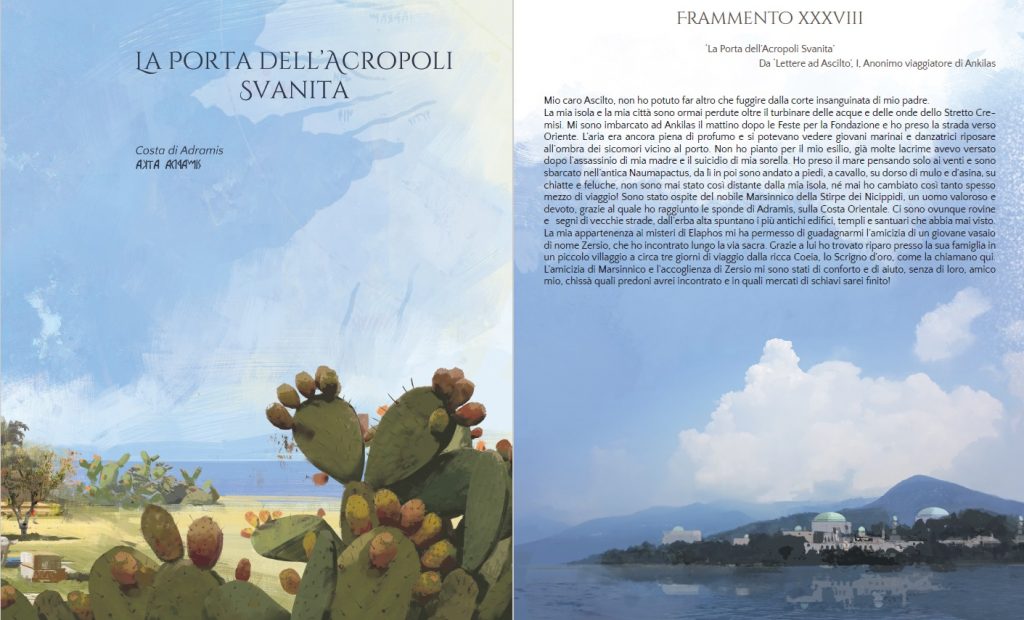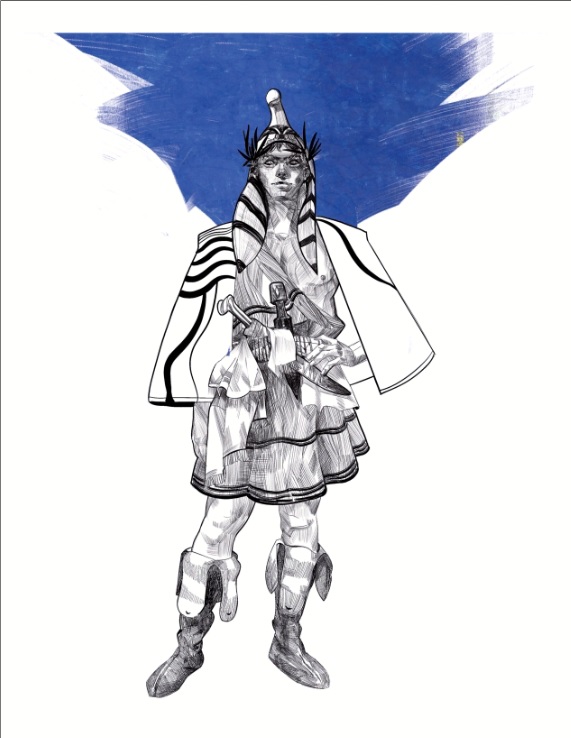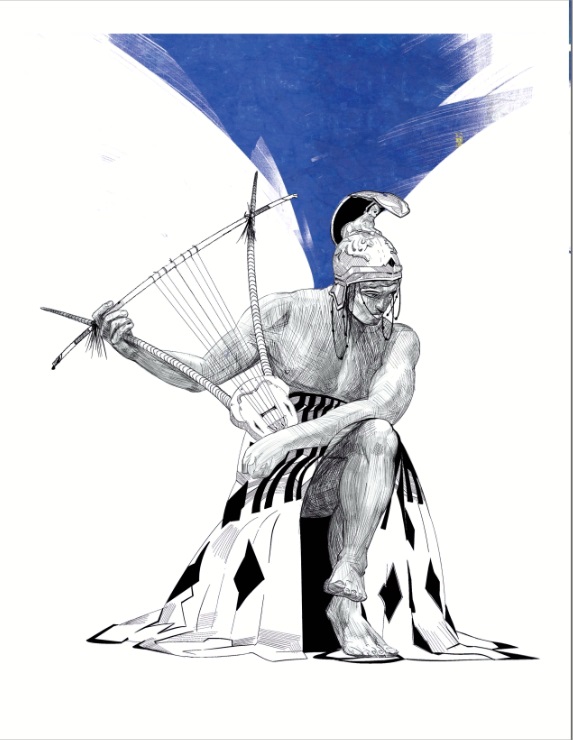Today we want to express our huge thanks to Massimiliano Haematinon Nigro for having sent us a physical review copy of Fragments of the Past Collector’s Edition. After one year and a half since we published our preview, we now have the pleasure of speaking about the complete game. First of all Fragments of the Past is a world. It is a vast setting described mostly through evocative literary fragments and magnificent illustrations, in a series of wonderful books. On the official website it is possible to find both the aforementioned volumes and the object of our review, the Fragments of the Past roleplaying game. This world is an alternative version of the Mediterranean Bronze Age born from the imagination of Massimiliano Haematinon Nigro, where the stories of peoples, heroes and gods unravel a new geography.
The products currently available on the site are:
- The Narrative Artbook, a collection of myths, drawings, artefacts, poems and stories from the ancient continent of Askedoria. 100 pages and more than 50 illustrations on habits and customs, men and gods, artifacts and talismans. Through dozens of fragments, readers will be able to rediscover the taste of ancient tales, a source of inspiration and a mine of information to experience even more intensely the fierce world of Fragments of the Past.
- The Design Works, a book that shows the creative process of worldbuilding along with the support of the community; excellent “behind the scenes” of this work.
- The Fragments of the Past Roleplaying Game, subject of our review.
- The free Quickstart for everyone who wants to take a look at the product. Made with great quality, it gives a good idea of the tone and content but does not give justice to the wonderful final result.

The Complete Indie Nature of the Project

I had the fortune and the pleasure to closely follow the development of Fragments of the Past, from when it was supposed to be the subject of a Kickstarter campaign up to its current version. For the author, Fragments of the Past represents so much and he has tried with all his determination to find the best way to share his vision with the world. Firmly intending not to make any kind of compromise, he rejected various possibilities that should have watered down his ideas. So in the end, after a long search, he came up with a completely independent solution: the printing and delivery of the book was entrusted to Lulu, a print-on-demand site. Fragments of the Past is exactly the book Massimiliano wanted, with its paper weight, color palette, layout and contents that he had thought of. And there’s nothing to do but be grateful for it.
Not having compromises also means not looking for excuses or shortcuts to lower prices. The basic version of the manual costs €19.90 in digital format and €54.99 in physical A4 format. The Collector’s Edition, of which I will explain the differences later on, costs €24.90 and €69.99 respectively in the two formats. These are certainly above average prices, as is the quality compared to various other products. Not every other product, I certainly don’t want to celebrate this work beyond its merits. However, it must be said that in addition to a role-playing game, you are buying a real artbook by an artist of the highest level, Massimiliano Haematinon Nigro.
Yes, always him. Massimiliano is the author, worldbuilder and illustrator of the game. He is its father, soul and lover. Luckily for us a non-jealous lover.
Core Version and Collector’s Edition

Before going into the details of this review of Fragments of the Past, I would like to analyze the differences between the two versions, to better guide the choice.
The core version comprises 187 richly illustrated full-color pages that include an introduction to the themes, world, geography and history of the continent of Askedoria, and a discussion about its gods and religions. The setting ends with a chapter dedicated to the events and traditions of the main peoples. Then the real roleplaying game part begins, with the creation of the characters and the rules. In the end we find a section dedicated to the Narrator and an introductory adventure, the same of the quickstart. The manual closes with a handy summary of the rules and a glossary. This book also contains further fragments which ideally continue the fragmented lore of the Narrative Artbook.
The Collector’s Edition is embellished both in terms of content and materials. There are ten additional pages on civilizations, two extra fragments, a dust jacket with an original illustration that protects a blue cloth cover engraved with golden letters.
But no matter which version you choose, it’s still hard to be disappointed.
Review of the Art of Fragments of the Past

Massimiliano Haematinon Nigro is an artist far beyond Fragments of the Past. He is a creative designer by profession whose fields of work range from gaming to cinema. He has great experience and an enormous talent on his side, not only in my humble and amateur opinion. It is therefore almost superfluous for me to write how absolutely stunning the quality of the art is. Fortunately, it is possible to view a large number of his works concerning Fragments of the Past on the internet. From the project site to its ArtStation page to the quickstart of the game, it is already possible to get an excellent idea of the artistic level offered.
I can only add that having the complete physical product in your hands and browsing through the pages it is truly a pleasure from every point of view. All the wonderful double-page landscapes, the evocative character designs and the realistic objects. The latter, together with the fragments, almost give the idea of being in front of a real history book or archeology treatise and contribute enormously to the attractiveness of the product.
The layout is beautiful, clear, with a clever use of blue both for the bolding of the main concepts in the mechanics part and for the creation of artistic text boxes. It’s also really nice how the layout gives space to art. Illustrations and content are equally important and equally exalted in a skilful combination.
The Manual That Is not a Manual

The Fragments of the Past manual is not your typical RPG handbook. As I’ve already mentioned when talking about art, one gets the feeling that it’s more of a book of another genre. If the illustrations turn the perception towards an archeology treatise, the narrative style leads the reader to a completely different direction. While not completely betraying the descriptive and didactic approach of a RPG manual, game concepts are included in broader discourses, sometimes without an indicative title. This detail also represents a limitation. A more analytical procedure would facilitate the consultation and retrieval of notions.
But I found this choice romantically fascinating. Fragments of the Past is de facto composed of fragments. Visual, literary, conceptual. It is something that cannot be studied in detail or completely. It is something that must be embraced, discovered and perceived in its essence. Then the empty spaces left by these fragments must be filled with the breaths full of passion that will come out from our desire to live in that world and that will make it unique. A similar treatment must be reserved for the system which, as we shall see, is far from detailed and complete.
Even the notions about the setting are not always presented in the classic way. Some information are evoked in the midst of other concepts, as if they came out spontaneously during a narration in front of a fire on a summer night under a starry sky. Like we all learned the geography and history of Middle-Earth before atlases and manuals came out: through the fragments that Tolkien gave us in his books and stories.
Review of the Setting of Fragments of the Past
You don’t need to know every corner of Askedoria to play. Immerse yourself in this great sea and decide freely what to take and what not. Both those who swim on its blue surface and those who descend into its dark depths will find the treasures they seek.

The manual dedicates 55 pages to the setting, including illustrations. In this relatively small space it tries to geographically describe an entire continent, its peoples, gods, customs and history. It is obviously impossible to think that the texts are detailed. Brushstrokes are provided that serve to direct the reader’s mind and imagination. Since the manual is already almost a synthetic summary of innumerable notions, it is difficult for me to condense them even further and give an idea of the contents in a few lines.
I therefore prefer to try to communicate the meaning of what is written. The world that is presented is not a “copy, mix and paste” of the ancient peoples of the Mediterranean. It’s not a reskin. Obviously the elements cannot be completely invented all from scratch. But I assure you that delving into the pages of Fragments of the Past gives the impression of discovering new peoples and cultures that have emerged from some revolutionary archaeo-anthropological study.
Etoi and Iskuzai

The two cultures, the two peoples that are most thoroughly explored are the Etoi and the Iskuzai.
The former are a mysterious people of the sea who have come from far away. They brought faith in Twelve Gods and many noble arts to the continent of Askedoria. They founded kingdoms governed by important cities. These cities are ruled by an alliance of matriarchal political-religious communities called Tiasi.
Subsequently the Iskuzai arrived, a superstitious people, lovers of war and poetry, capable of absorbing the culture of the civilizations with which they come into contact. They revere the Double-Crested Panther and under the guidance of the great King Auleus, the Cartographer, they came into contact and then warred with the Etoi. From this encounter-clash, a cultural mingling and an explosion of stories, myths, situations and narrative ideas are born.
These two peoples are described with originality and mastery in countless aspects. Social structure, rituals, religion, beliefs, customs, history, organization, mentality. The picture presented, albeit synthetic, is profound and, most important, consistent.
Obviously Etoi and Iskuzai are not the only peoples of Askedoria. the ancient Agrauran, builders of underground necropolises, the cultured Molubdenoi, wise prince-merchants, the audacious Hattusas, navigators of the most insidious waves and the Kokhlidoi, embalmers and worshipers of the stars, fill the kaleidoscopic fresco of Fragments of the Past.
Gods and Divine

The world of Fragments of the Past is rich in the Divine. One of the tenets of the game states that “everything is divine”. I think it is important to underline this aspect: we are not talking about a game where gods like Zeus or Ares walk the earth or directly influence events. Nor is the magic present irrefutably. There are neither fireballs nor lightning bolts fired from the fingers of spellcasters. But lightning is a manifestation of the divine. As well as the wind, the growing crops or a famine.
Magical and Divine are present at the gaming table, for the players and the game master. But narratively the men and women of Askedoria, even the great sages or heroes, are very similar to our ancestors of ancient times. They see the divine in every manifestation of nature whose power or mystery is beyond their rational understanding. Consequently, each event can be enriched with symbolism, interpretations, meanings, which will amplify the narration and take it to epic levels. Or tragic ones, as we shall see.
Fragments of the Past is more than a collection of mysterious rituals and bloody legends, it’s an emotion: wonder and nostalgia for the fierce beauty of the archaic past.
Review of the Ruleset of Fragments of the Past
I left the analysis of the Fragments of the Past game system at the end of the article. I had so many things to say that I had to make choices after all! This paragraph is so near the conclusion because I found the system to be one of the least important aspects of the game. Don’t get me wrong, the system is essential to play and its absolute value in the success of each product should certainly not be underestimated. But Fragments of the Past is so full of epic power and passion that the emphasis should not be placed on the system, but on the narrative and the emotions it gives in recreating a type of story that has always touched the hearts of mankind.
This is why we are talking about an incredibly light and not very detailed ruleset, sometimes too much fragmented. Basically, the d100 is rolled with the aim of obtaining a lower result than the reference characteristic. There are four of them: Soma, Sarx, Psyche and Pneuma, more or less related to Body, Charisma, Wit and Divine. All checks fall into those categories except Voluntas (Willpower), Fortuna (Luck), and Hybris (Hubris) which are managed through a d10 and which are stackable/consumable resources with various effects. Where the Voluntas facilitates successes and Fortuna avoids harmful consequences, the accumulation of Hybris leads to the occurrence of misfortunes or ever greater difficulties.
But consider that the system only occupies 12 pages, examples included. There are a few other rules but very impacting the narrative, such as Blessings and Curses or Talismans.




Combat
Then there’s the combat, so light it’s almost narrative, yet highly deadly. Fragments of the Past does not satisfy lovers of grids and options, nor those who seek perfect balanced simulations. It’s a game of stories and passions and you have to be ready to pass over unregulated situations.
Weapons do fixed damage, which increases on localized hits, but there are no rules for locating attacks. The fight follows the flow of the narrative and lives in the theater of the minds. There must be a good harmony at the table and the awareness that you don’t play to make critical hits decapitating heads with every roll of the dice, even if it would be possible describing it. On the other hand, the high mortality is given both by the high risk that fatigue leads to a rapid worsening of the attributes (and therefore of the success of the shots), but above all by the fact that the fighting tests are based on Soma. But Soma also represents the characters’ hit points, so taking wounds brings you closer to death and significantly worsens your ability to fight.
In fact another cornerstone of the game is that “Life is splendid, terrible and SHORT”.




Characters and Stories of Fragments of the Past
Characters have no classes or other archetypes. They are individuals characterized not by differences in their attributes, which are often minimal. Their main features are given by three very important game elements. The Gift, the Passion and the Epithets. Not numbers, but game concepts.
Gifts are the divine spark of the character’s narrative, a sort of “power” whose manifestation, however, is always intangible. Each character has one decided at character creation. Opposite to it there is the Passion, “the most painful and tormented part of a character”, his inner conflict that is externalized through a vice, a defect, a problem, an obstacle, something that generates history, interpretation and, above all, pathos. Finally there are the Epithets, real labels which, as in ancient poems, are connected to a hero on the basis of deeds or characteristics and which have both a narrative and regulatory impact, usually in the form of numerical bonuses. There are 120 of them in the manual and they allow for great customization, really touching on many aspects and literary tropes.
Characters are the engine of stories. Fragments of the Past was born to tell two types of narratives: epic cycles and tragedies. On the one hand the legends of immortal deeds of new Achilles, Diomedes, Jason and Theseus. On the other hand, the distressing stories of tormented characters deeply excavated by events, like Oedipus, Medea, Antigone or Clytemnestra.
An example of tragedy is the introductory adventure, “The Fate of the City of Morays“, very well written and fun to play. We have published our own attempt:
Final Considerations

Fragments of the Past is a world that could have been and was not. You will be the protagonist of a poem sung amidst the red fires of a banquet, you will take on the role of terrible characters, whose prodgious nature is manifested in the breadth of their passions, in the wildness of their instincts and in the sacrifices they are ready to make. You will live in a wonderful and cruel reality, the protagonist of stories marked by bloody curses, duels and complex rituals.
Writing the review of Fragments of the Past was not easy. Both due to the difficulty of remaining objective with a game to which I am emotionally attached, and because I found challenging sharing with you the characteristics and strengths of a fascinating but particular product. The game world has a different inspiration from the usual Northern European fantasy. It was also completely created from scratch so it is impossible to convey all the vivid variety it offers. The graphic beauty and romantic writing style can only be hinted at and my few lines have not done them justice enough.
I can only warmly recommend it. Obviously every player has his own tastes and some features of Fragments of the Past may not be liked. There is no way to mitigate them. This product is made in its own way and it must be experienced as described, with its strengths and weaknesses. Anyone who has found more strengths than weaknesses in my review and was intrigued even a little by Fragments of the Past can be sure that they will be incredibly satisfied. I give you my word.

